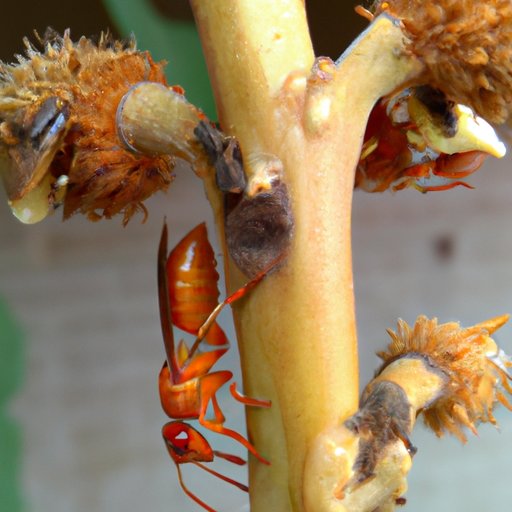Introduction
Symbiotic relationships are all around us, from the microscopic level in our soil to the complex interdependence of different animal species. Understanding symbiosis is crucial to understanding how our world functions as a whole.
In this article, we’ll explore the concept of symbiotic relationships, the different types of symbiosis, and their roles in maintaining healthy ecosystems. We’ll take a closer look at some fascinating examples of mutualistic relationships between different organisms and the benefits they provide. Finally, we’ll discuss the implications of not understanding or respecting these relationships and why it’s essential that we do.
The Secret Life of Symbiotic Relationships: Understanding the Interdependence of Living Organisms
At their core, all living organisms are interconnected, and symbiotic relationships are the very foundation of life. The term “symbiosis” stems from the Greek words “sun” and “biosis,” meaning “living together.” It refers to a close association between two or more species, where at least one species benefits from the relationship.
Symbiotic relationships play a vital role in maintaining the balance of ecosystems worldwide. Each species is an essential part of the web of life, and they rely on each other for survival. Even small changes in one area of the ecosystem can have far-reaching effects.
Examples of symbiosis in the natural world are everywhere. Certain types of bacteria live inside the digestive tracts of cows and other ruminants, aiding in the digestion of tough plant material. Birds and large mammals, such as rhinos and elephants, act as distributors of seeds, carrying them for miles and planting them in new areas. Every part of an ecosystem is intertwined in a delicate balance, and symbiotic relationships are what keep it functioning.
Symbiosis 101: Exploring the Mutualistic Relationships of the Natural World
Mutualism is one of the numerous ways symbiotic relationships can manifest in the natural world. It occurs when two or more species benefit from the association, often in ways that would be impossible for either species to achieve alone. An example of mutualism is the relationship between flowering plants and their pollinators, such as bees and butterflies. Pollinators receive food in the form of nectar from the flowers while inadvertently transferring the plant’s pollen from one flower to another. This mutualistic relationship ensures that both the plant and the pollinator survive and thrive.
There are other types of symbiotic relationships as well, such as commensalism, where one species benefits from the association while the other is unaffected, and parasitism, where one species benefits at the expense of the other.
Examples of mutualistic relationships in nature are plentiful. Acacia trees and ants, for example, have a mutualistic relationship where the tree provides nectar for the ants, while the ants protect the tree from harmful insects. This relationship has existed for millions of years and has evolved to become incredibly intricate and sophisticated.
From Flowers to Fungi: A Close Look at Different Types of Symbiotic Relationships
Symbiotic relationships exist between plants and animals, as well as in the soil microorganisms that play a crucial role in the web of life. Mycorrhizal fungi, for example, live in mutualistic relationships with plants, where the fungus absorbs nutrients from the soil and transports them to the plant.
There are many other types of symbiotic relationships, such as those between algae and fungi in lichen, which create a new organism with entirely different properties than either of its individual components. These relationships are essential components of biodiversity, helping to ensure that ecosystems are resilient and can withstand change.
The Evolution of Mutualism: Tracing the History of Symbiotic Relationships
Symbiotic relationships have existed since the dawn of life on this planet and have played a crucial role in the evolution of species. The ability of different organisms to cultivate a mutually beneficial relationship has allowed species to thrive in new environments and adapt to changing circumstances.
From the very first lichens to the complex relationships between bees and flowering plants, symbiosis has been driving the evolution of life on Earth. Today, symbiotic relationships continue to shape and influence the natural world, and they’ll be essential as we move forward in our efforts to understand and care for our planet.

Why Working Together is Better: The Benefits of Symbiotic Relationships in Ecosystems
Symbiotic relationships play a crucial role in maintaining healthy ecosystems, and mutualistic relationships, in particular, provide several benefits for the organisms involved. Plants and animals that are in mutually beneficial relationships tend to be healthier and produce more offspring than those that are isolated. They’re also more resilient to changes in their environment, with the relationship providing an extra layer of protection.
Mutualistic relationships also contribute to biodiversity, which is essential for healthy ecosystems. They enable different species to coexist and find ways to thrive and evolve together. As such, it’s crucial that we continue to respect and pay attention to these relationships and work to preserve them wherever possible.
Bees and Flowers, Ants and Acacia Trees: Fascinating Examples of Symbiotic Relationships
There are many fascinating examples of mutualistic relationships in nature, from the well-known relationship between bees and flowers to the complex relationship between ants and acacia trees. Bees and flowers develop co-dependency over time, with the form, odor, and color of flowers changing as bees become more reliant on them for food. In some cases, this has led to the flowers evolving to look like insects to attract specific pollinators.
Ants and acacia trees, on the other hand, have developed an intricate mutualistic relationship where the tree provides nectar and a home for the ants, while the ants protect the tree from harmful insects. The relationship has evolved over millions of years, with both sides developing ways to benefit the other.
Symbiosis and Survival: How Organisms Rely on Each Other for Success
The importance of symbiotic relationships cannot be overstated. Organisms rely on each other for survival and success, and a breakdown of these relationships can have catastrophic consequences. By respecting and nurturing these relationships, we can continue to thrive as a species and safeguard our planet for generations to come.
Understanding the delicate web of life that connects all living organisms is crucial in our fight to preserve and protect wildlife habitats, oceans, and forests. By recognizing the interdependence of all living things, we can work to ensure that the next generation will inherit a world that is as rich, diverse, and awe-inspiring as the one we know today.
Conclusion
From the smallest bacteria to the largest mammals, symbiotic relationships are what lie at the heart of all life on earth. They play a vital role in the maintenance of ecosystems worldwide, and without them, the world, as we know it today, would look entirely different.
By taking the time to learn about and understand symbiotic relationships, we can continue to protect and preserve our planet, ensuring that it remains a beautiful, diverse, and thriving home to all living things, big and small.
Let’s celebrate and encourage these fascinating and essential relationships and work together to ensure that they continue to thrive for generations to come.
